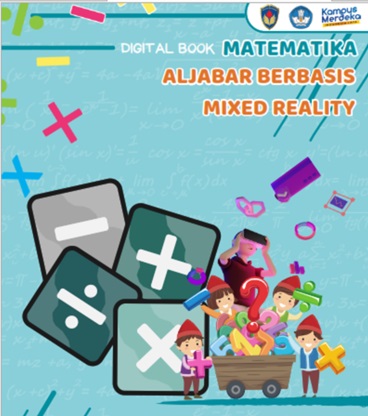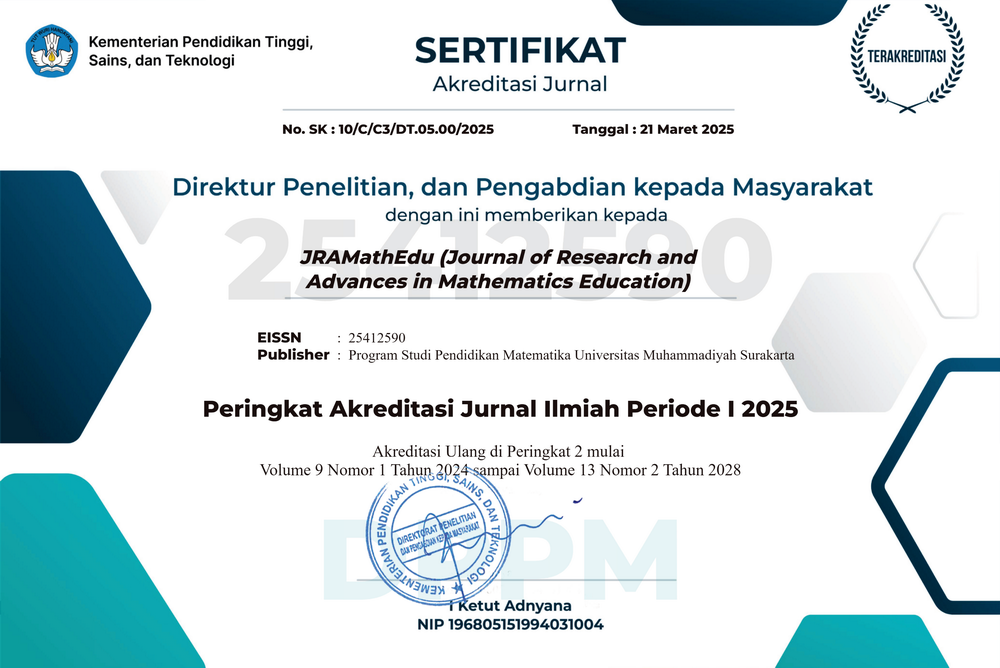Design of algebra digital book on mixed reality-based to improve learner's numeracy literacy
DOI:
https://doi.org/10.23917/jramathedu.v9i4.4745Keywords:
Digital book, Mixed reality, Literacy, NumeracyAbstract
The development of digital technology in the world of education is currently growing very rapidly, one of which is digital books. Digital books become more interesting if they can present the real environment around students in a virtual form. One technology that can present the real world environment into digital objects and can interact is Mixed Reality. The purpose of this research is to produce a Mixed Reality-based Digital Book on algebra material that is valid and feasible to use in improving students' numeracy literacy skills so that it can support learning. This study uses the Borg and Gall research and development pattern method. Data is taken through expert validation and readability tests for product testing. In the media expert validation which includes general aspects, aspects of learning presentation, aspects of language feasibility, aspects of graphics meet the valid criteria with an average value of five validators 89.2%. In the material expert validation which includes general aspects, aspects of material substance, learning aspects, aspects of usefulness meet the valid criteria with an average score of five validators 92.6%. In the readability test, teachers and lecturers obtained an average of 86% and the readability test on students obtained an average of 80%. Based on the results of media and material validation along with the Mixed Reality-based Digital Book readability test on algebra material, it is concluded that it is valid and feasible to use. The implication of this research is that it makes it easier for students to learn by using digital books to support learning in the classroom so that they can improve their achievement.
References
Agustina, L., & Martha Rusmana, I. (2019). Pembelajaran Matematika Menyenangkan Dengan Aplikasi Kuis Online Quizizz. AL-IDARAH Jurnal Kependidikan Islam, 9,1-7
Ali, D. F., Omar, M., Boon, Y., Ahmad, J., Wahid, N. H. A., Noordin, M. K., ... & Ibrahim, M. A. (2018). The use of augmented reality learning environment in enhancing students’ mental rotation skills. Advanced Science Letters, 24(5), 3705-3708. DOI: https://doi.org/10.1166/asl.2018.11470
Amin, F. M., & Sundari, H. (2020). Efl students’ preferences on digital platforms during emergency remote teaching:Video conference, lms, or messenger application?. Studies in English Language and Education, 7(2), 362-378. https://doi.org/10.24815/siele.v7i2.16929 DOI: https://doi.org/10.24815/siele.v7i2.16929
Awang, N. H. (2010). BUKU VS E-BUKU: TRANSFORMASI ERA DIGITAL. Jurnal PPM, 5, 1–14.
Bacca, J., Baldiris, S., Fabregat, R., Graf, S., & Kinshuk (2014). Augmented reality trends in education: A systematic review of research and applications. Journal of Educational Technology & Society, 17(4), 133–149.
Cabero-Almenara, J.; Vázquez-Cano, E.; López-Meneses, E.; Jaén, A. Posibilidades formativas de la tecnología aumentada. Unestudio diacrónico en escenarios universitarios. Rev. Complut. Educ. 2020, 31, 143–154. DOI: https://doi.org/10.5209/rced.61934
Cabero-Almenara, J., Llorente-Cejudo, C., & Martinez-Roig, R. (2022). The use of mixed, augmented and virtual reality in history of art teaching: A case study. Applied System Innovation, 5(3), 44. DOI: https://doi.org/10.3390/asi5030044
Carre, A.L., Dubois, A., Partarakis, N., Zabulis, X., Patsiouras, N., Mantinaki, E., Zidianakis, E., Cadi, N., Baka, E., Thalmann, N.M., Makrygiannis, D., Glushkova, A. and Manitsaris, S. (2022), “Mixed-reality demonstration and training of glassblowing”, Heritage, Vol. 5 No. 1, pp. 103-128, https://doi.org/10.3390/heritage5010006. DOI: https://doi.org/10.3390/heritage5010006
Devetak, I., & Vogrinc, J. (2013). The Criteria for Evaluating the Quality of the Science Textbooks. In Critical Analysis of Science Textbooks. https://doi.org/10.1007/978-94-0074168-3_1 DOI: https://doi.org/10.1007/978-94-007-4168-3_1
Echavez Jr, A., Yncierto, C., Obiasada, R., Dayag, M., Alcazar, R., & Kilag, O. K. (2024). Advancing Literacy and Numeracy: Exploring Trends and Strategies for Elementary School Students. International Multidisciplinary Journal of Research for Innovation, Sustainability, and Excellence (IMJRISE), 1(2), 144-150.
Ekowati, D. W., Astuti, Y. P., Utami, I. W. P., Mukhlishina, I., & Suwandayani, B. I. (2019). Literasi Numerasi di SD Muhammadiyah. ELSE (Elementary School Education Journal) : Jurnal Pendidikan Dan Pembelajaran Sekolah Dasar, 3(1), 93. https://doi.org/10.30651/else.v3i1.2541 DOI: https://doi.org/10.30651/else.v3i1.2541
Fang, H.G., Liu, P. and Huang, R.H. (2011). “The Research on E-book-oriented Mobile Learning System Environment Application and Its Tendency”. Modern Educational Technology, (12):18-23.
Fatahillah, A., Puspitasari, I. D., & Hussen, S. (2020). The Development of Schoology Web-Based Learning Media with GeoGebra to Improve the ICT Literacy on Quadratic Functions. Journal of Research and Advances in Mathematics Education, 5(3), 304-316. DOI: https://doi.org/10.23917/jramathedu.v5i3.10692
Febriana, A., & Nugroho, A. A. (2023). Pengembangan digital book Berbasis Asesmen Kompetensi Minimum (AKM) untuk meningkatkan literasi membaca peserta didik. Pendas: Jurnal Ilmiah Pendidikan Dasar, 8(1), 524-538.
Gattullo, M., Laviola, E., Boccaccio, A., Evangelista, A., Fiorentino, M., Manghisi, V. M., & Uva, A. E. (2022). Design of a mixed reality application for STEM distance education laboratories. Computers, 11(4), 50. DOI: https://doi.org/10.3390/computers11040050
Kementerian Pendidikan dan Kebudayaan. (2022). Laporan tahunan digitalisasi sekolah 2022. Jakarta: Kementerian Pendidikan dan Kebudayaan. https://www.kemdikbud.go.id/main/blog/2022/02/laporan-tahunan-digitalisasi-sekolah-2022
Kementerian Pendidikan dan Kebudayaan. (2024). Laporan tahunan Program Merdeka Belajar 2024. Jakarta: Kementerian Pendidikan dan Kebudayaan. https://www.kemdikbud.go.id/main/blog/2024/03/laporan-tahunan-program-merdeka-belajar-2024
Hamiedah, D., Fauziyah, N., & Huda, S. (2023). Pengembangan E-modul Menggunakan Aplikasi Ispring Suite 10 dengan Penguatan Literasi Numerasi pada Peserta Didik SMP. DIDAKTIKA : Jurnal Pemikiran Pendidikan, 29(1), 73. https://doi.org/10.30587/didaktika.v29i1.5176 DOI: https://doi.org/10.30587/didaktika.v29i1.5176
Holz, T., Campbell, A. G., O’Hare, G. M. P., Stafford, J. W., Martin, A., & Dragone, M. (2011). MiRA – Mixed reality agents. International Journal of Human–Computer Studies, 69(4), 251–268. https://doi.org/10.1016/j.ijhcs.2010.10.1 DOI: https://doi.org/10.1016/j.ijhcs.2010.10.001
Hull, S. S., & Chaparro, B. S. (2006). USABILITY EVALUATION OF DIGITAL FLIPVIEWER® ONLINE FLIPBOOKS. 1839–1843. DOI: https://doi.org/10.1177/154193120605001726
Islam Sarker, M. N., Wu, M., Cao, Q., Alam, G. M. M., & Li, D. (2019). Leveraging Digital Technology for Better Learning and Education: A Systematic Literature Review. International Journal of Information and Education Technology, 9(7), 453-461. https://doi.org/10.18178/ijiet.2019.9.7.1246 DOI: https://doi.org/10.18178/ijiet.2019.9.7.1246
José Antonio Cordón-García, Daniel Linder, R. G.-D. and J. A.-A. (2016). E-Book publishing in Spain The paradoxes of a dual model. Journal of Enterprise Information Management, 29(1), 118–139.
Kaplan, A. D., Cruit, J., Endsley, M., Beers, S. M., Sawyer, B. D., & Hancock, P. A. (2021). The effects of virtual reality, augmented reality, and mixed reality as training enhancement methods: A meta-analysis. Human factors, 63(4), 706-726. DOI: https://doi.org/10.1177/0018720820904229
Kebudayaan, K. P. dan. (2017). Gerakan Literasi Nasional. http://gln.kemdikbud.go.id.
Kerdvibulvech, C. (2022), “Geo-Based mixed reality gaming market analysis”, Human Behavior and Emerging Technologies, pp. 1-9, https://doi.org/10.1155/2022/1139475 DOI: https://doi.org/10.1155/2022/1139475
Kovalenko, V., Marienko, M., & Sukhikh, A. (2022). Use of augmented and virtual reality tools in a general secondary education institution in the context of blended learning. arXiv preprint arXiv:2201.07003. DOI: https://doi.org/10.33407/itlt.v86i6.4664
Lavicza, Z., Weinhandl, R., Prodromou, T., Anđić, B., Lieban, D., Hohenwarter, M., ... & Diego-Mantecón, J. M. (2022). Developing and evaluating educational innovations for STEAM education in rapidly changing digital technology environments. Sustainability, 14(12), 7237. DOI: https://doi.org/10.3390/su14127237
Leonard, S.N. and Fitzgerald, R.N. (2018), “Holographic learning: a mixed reality trial of Microsoft HoloLens in an Australian secondary school”, Research in Learning Technology, Vol. 26, https://doi.org/25304/rlt.v26.2160 DOI: https://doi.org/10.25304/rlt.v26.2160
Lindgren, R., & Johnson-Glenberg, M. (2013). Emboldened by embodiment: Six precepts for research on embodied learning and mixed reality. Educational Researcher, 42(8), 445–452. https://doi.org/10.3102/13189X13511661 DOI: https://doi.org/10.3102/0013189X13511661
Li, L., Wang, D., Qin, W.S., Zhang S.Q. and Gao, X. (2011). “On the Inevitability of the Development Trend of Electronic Teaching Materials Replacing Paper Teaching Materials”. China Information Times, (5):42-44.
Lovenburg, N. (2018). Journey within Afghanistan: Inside creative’s digital book tracking system. Childhood Education, 94(5), 52–57. https://doi.org/10.1080/00094056.2018.1516473 DOI: https://doi.org/10.1080/00094056.2018.1516473
Maas, M. J., & Hughes, J. M. (2020). Virtual, augmented and mixed reality in K–12 education: A review of the literature. Technology, Pedagogy and Education, 29(2), 231-249. DOI: https://doi.org/10.1080/1475939X.2020.1737210
Manolitsis, G., Georgiou, G. K., & Tziraki, N. (2013). Examining the effects of home literacy and numeracy environment on early reading and math acquisition. Early Childhood Research Quarterly, 28(4), 692-703. DOI: https://doi.org/10.1016/j.ecresq.2013.05.004
Marın, V. and Vega, E. (2022), “La formacion del docente de ense~nanza secundaria en torno a larealidad mixta en ambitos inclusivos”,inSanchez-Rivas, E., Colomo-Magana, E., Ruiz-Palmero, J. and Gomez-Garcıa, M. (Eds), La tecnologıa educativa como eje vertebrador de la innovacion, Octaedro, Barcelona, pp. 73-85.
Maulita, I. (2023). Analisis Kelayakan Bahan Ajar Berbasis Literasi Sains Pada Tema Gaya. Perwira Journal of Economics & Business, 3(01), 84-90.
Nugroho, A. A., & Purwati, H. (2015). Pengembangan Media Pembelajaran Matematika Berbasis Mobile Learning Dengan Pendekatan Scientific. Euclid, 2(1). https://doi.org/10.33603/e.v2i1.355 DOI: https://doi.org/10.33603/e.v2i1.355
Nurhayati, D. (2017). Developing Interactive Digital Book for The Development of E-Learning Course on Educational Technology Students of Faculty of Science Education, Yogyakarta State University. E-Jurnal Prodi Teknologi Pendidikan, VI(5), 458–473.
OECD, PISA 2018 Results (Volume VI) : Are Students Ready to Thrive in an Interconnected World?. Paris: OECD Publishing, 2020.
Ogunseiju, O. R., Gonsalves, N., Akanmu, A. A., Bairaktarova, D., Bowman, D. A., & Jazizadeh, F. (2022). Mixed reality environment for learning sensing technology applications in Construction: A usability study. Advanced Engineering Informatics, 53, 101637. DOI: https://doi.org/10.1016/j.aei.2022.101637
Park, B., Chang, H., & Park, S. (Steven). (2019). Adoption of digital devices for children education: Korean case. Telematics and Informatics, 38(November), 247–256. https://doi.org/10.1016/j.tele.2018.11.002 DOI: https://doi.org/10.1016/j.tele.2018.11.002
Putri, F. S. (2022). Aplikasi Multimedia dan Model Pembelajaran Blended Learning untuk Literasi Numerasi Peserta Didik Sekolah Dasar. Jurnal Pendidikan, 22(2), 155–161. https://doi.org/10.52850/jpn.v22i2.3918 DOI: https://doi.org/10.52850/jpn.v22i2.3918
Radu, I. (2014). Augmented reality in education: A meta-review and cross-media analysis. Personal and Ubiquitous Computing, 18(6), 1533–1543. https://doi.org/10.1007/s00779-13-747-y DOI: https://doi.org/10.1007/s00779-013-0747-y
Ran, W., & Jinglu, L. (2020, October). The design and development of digital books for e-learning. In 2020 4th International Conference on Artificial Intelligence and Virtual Reality (pp. 51-55). DOI: https://doi.org/10.1145/3439133.3439140
Razak, A. N. A., Noordin, M. K., & Khanan, M. F. A. (2022). Digital learning in technical and vocational education and training (TVET) in public university, malaysia. Journal of Technical Education and Training, 14(3), 49-59. DOI: https://doi.org/10.30880/jtet.2022.14.03.005
Siregar, B. H., Mansyur, A., & Siregar, N. (2021). Development of digital book in enhancing students’ higher-order thinking skill. In Journal of Physics: Conference Series (Vol. 1819, No. 1, p. 012046). IOP Publishing. DOI: https://doi.org/10.1088/1742-6596/1819/1/012046
Sugiyono. (2016). Metode Penelitian Pendekatan Kuantitatif Kualitatif dan R&D. Alfabeta.
Utami, R. E., Nugroho, A. A., Dwijayanti, I., & Sukarno, A. (2018). Pengembangan E-Modul Berbasis Etnomatematika Untuk Meningkatkan Kemampuan Pemecahan Masalah. JNPM (Jurnal Nasional Pendidikan Matematika), 2(2), 268. https://doi.org/10.33603/jnpm.v2i2.1458 DOI: https://doi.org/10.33603/jnpm.v2i2.1458

Submitted
Accepted
Published
How to Cite
Issue
Section
License
Copyright (c) 2024 Aryo Andri Nugroho Aryo

This work is licensed under a Creative Commons Attribution-NonCommercial 4.0 International License.


















